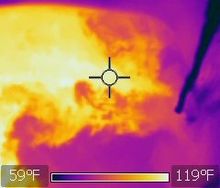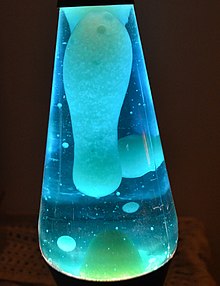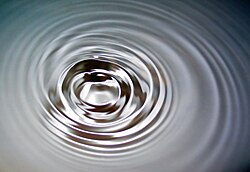
A | B | C | D | E | F | G | H | CH | I | J | K | L | M | N | O | P | Q | R | S | T | U | V | W | X | Y | Z | 0 | 1 | 2 | 3 | 4 | 5 | 6 | 7 | 8 | 9

| Part of a series on |
| Continuum mechanics |
|---|
A liquid is a nearly incompressible fluid that conforms to the shape of its container but retains a nearly constant volume independent of pressure. It is one of the four fundamental states of matter (the others being solid, gas, and plasma), and is the only state with a definite volume but no fixed shape.
The density of a liquid is usually close to that of a solid, and much higher than that of a gas. Therefore, liquid and solid are both termed condensed matter. On the other hand, as liquids and gases share the ability to flow, they are both called fluids.
A liquid is made up of tiny vibrating particles of matter, such as atoms, held together by intermolecular bonds. Like a gas, a liquid is able to flow and take the shape of a container. Unlike a gas, a liquid maintains a fairly constant density and does not disperse to fill every space of a container.
Although liquid water is abundant on Earth, this state of matter is actually the least common in the known universe, because liquids require a relatively narrow temperature/pressure range to exist. Most known matter in the universe is either gas (as interstellar clouds) or plasma (as stars).
Introduction

Liquid is one of the four primary states of matter, with the others being solid, gas and plasma. A liquid is a fluid. Unlike a solid, the molecules in a liquid have a much greater freedom to move. The forces that bind the molecules together in a solid are only temporary in a liquid, allowing a liquid to flow while a solid remains rigid.
A liquid, like a gas, displays the properties of a fluid. A liquid can flow, assume the shape of a container, and, if placed in a sealed container, will distribute applied pressure evenly to every surface in the container. If liquid is placed in a bag, it can be squeezed into any shape. Unlike a gas, a liquid is nearly incompressible, meaning that it occupies nearly a constant volume over a wide range of pressures; it does not generally expand to fill available space in a container but forms its own surface, and it may not always mix readily with another liquid. These properties make a liquid suitable for applications such as hydraulics.
Liquid particles are bound firmly but not rigidly. They are able to move around one another freely, resulting in a limited degree of particle mobility. As the temperature increases, the increased vibrations of the molecules causes distances between the molecules to increase. When a liquid reaches its boiling point, the cohesive forces that bind the molecules closely together break, and the liquid changes to its gaseous state (unless superheating occurs). If the temperature is decreased, the distances between the molecules become smaller. When the liquid reaches its freezing point the molecules will usually lock into a very specific order, called crystallizing, and the bonds between them become more rigid, changing the liquid into its solid state (unless supercooling occurs).
Examples
Only two elements are liquid at standard conditions for temperature and pressure: mercury and bromine. Four more elements have melting points slightly above room temperature: francium, caesium, gallium and rubidium.[1] In addition, certain mixtures of elements are liquid at room temperature, even if the individual elements are solid under the same conditions (see eutectic mixture). An example is the sodium-potassium metal alloy NaK.[2] Other metal alloys that are liquid at room temperature include galinstan, which is a gallium-indium-tin alloy that melts at −19 °C (−2 °F), as well as some amalgams (alloys involving mercury).[3]
Pure substances that are liquid under normal conditions include water, ethanol and many other organic solvents. Liquid water is of vital importance in chemistry and biology, and it is necessary for all known forms of life.[4][5]
Inorganic liquids include water, magma, inorganic nonaqueous solvents and many acids.
Important everyday liquids include aqueous solutions like household bleach, other mixtures of different substances such as mineral oil and gasoline, emulsions like vinaigrette or mayonnaise, suspensions like blood, and colloids like paint and milk.
Many gases can be liquefied by cooling, producing liquids such as liquid oxygen, liquid nitrogen, liquid hydrogen and liquid helium. Not all gases can be liquified at atmospheric pressure, however. Carbon dioxide, for example, can only be liquified at pressures above 5.1 atm.[6]
Some materials cannot be classified within the classical three states of matter. For example, liquid crystals (used in liquid-crystal displays) possess both solid-like and liquid-like properties, and belong to their own state of matter distinct from either liquid or solid.[7]
Applications

Lubrication
Liquids are useful as lubricants due to their ability to form a thin, freely flowing layer between solid materials. Lubricants such as oil are chosen for viscosity and flow characteristics that are suitable throughout the operating temperature range of the component. Oils are often used in engines, gear boxes, metalworking, and hydraulic systems for their good lubrication properties.[8]
Solvation
Many liquids are used as solvents, to dissolve other liquids or solids. Solutions are found in a wide variety of applications, including paints, sealants, and adhesives. Naphtha and acetone are used frequently in industry to clean oil, grease, and tar from parts and machinery. Body fluids are water-based solutions.
Surfactants are commonly found in soaps and detergents. Solvents like alcohol are often used as antimicrobials. They are found in cosmetics, inks, and liquid dye lasers. They are used in the food industry, in processes such as the extraction of vegetable oil.[9]
Cooling
Liquids tend to have better thermal conductivity than gases, and the ability to flow makes a liquid suitable for removing excess heat from mechanical components. The heat can be removed by channeling the liquid through a heat exchanger, such as a radiator, or the heat can be removed with the liquid during evaporation.[10] Water or glycol coolants are used to keep engines from overheating.[11] The coolants used in nuclear reactors include water or liquid metals, such as sodium or bismuth.[12] Liquid propellant films are used to cool the thrust chambers of rockets.[13] In machining, water and oils are used to remove the excess heat generated, which can quickly ruin both the work piece and the tooling. During perspiration, sweat removes heat from the human body by evaporating. In the heating, ventilation, and air-conditioning industry (HVAC), liquids such as water are used to transfer heat from one area to another.[14]
Cooking
Liquids are often used in cooking due to their excellent heat-transfer capabilities. In addition to thermal conduction, liquids transmit energy by convection. In particular, because warmer fluids expand and rise while cooler areas contract and sink, liquids with low kinematic viscosity tend to transfer heat through convection at a fairly constant temperature, making a liquid suitable for blanching, boiling, or frying. Even higher rates of heat transfer can be achieved by condensing a gas into a liquid. At the liquid's boiling point, all of the heat energy is used to cause the phase change from a liquid to a gas, without an accompanying increase in temperature, and is stored as chemical potential energy. When the gas condenses back into a liquid this excess heat-energy is released at a constant temperature. This phenomenon is used in processes such as steaming.
Distillation
Since liquids often have different boiling points, mixtures or solutions of liquids or gases can typically be separated by distillation, using heat, cold, vacuum, pressure, or other means. Distillation can be found in everything from the production of alcoholic beverages, to oil refineries, to the cryogenic distillation of gases such as argon, oxygen, nitrogen, neon, or xenon by liquefaction (cooling them below their individual boiling points).[15]
Hydraulics
Liquid is the primary component of hydraulic systems, which take advantage of Pascal's law to provide fluid power. Devices such as pumps and waterwheels have been used to change liquid motion into mechanical work since ancient times. Oils are forced through hydraulic pumps, which transmit this force to hydraulic cylinders. Hydraulics can be found in many applications, such as automotive brakes and transmissions, heavy equipment, and airplane control systems. Various hydraulic presses are used extensively in repair and manufacturing, for lifting, pressing, clamping and forming.[16]
Liquid metals
Liquid metals have several properties that are useful in sensing and actuation, particularly their electrical conductivity and ability to transmit forces (incompressibility). As freely flowing substances, liquid metals retain these bulk properties even under extreme deformation. For this reason, they have been proposed for use in soft robots and wearable healthcare devices, which must be able to operate under repeated deformation.[17][18] The metal gallium is considered to be a promising candidate for these applications as it is a liquid near room temperature, has low toxicity, and evaporates slowly.[19]
Miscellaneous
Liquids are sometimes used in measuring devices. A thermometer often uses the thermal expansion of liquids, such as mercury, combined with their ability to flow to indicate temperature. A manometer uses the weight of the liquid to indicate air pressure.[20]
The free surface of a rotating liquid forms a circular paraboloid and can therefore be used as a telescope. These are known as liquid-mirror telescopes.[21] They are significantly cheaper than conventional telescopes,[22] but can only point straight upward (zenith telescope). A common choice for the liquid is mercury.
Mechanical properties
Volume

Quantities of liquids are measured in units of volume. These include the SI unit cubic metre (m3) and its divisions, in particular the cubic decimeter, more commonly called the litre (1 dm3 = 1 L = 0.001 m3), and the cubic centimetre, also called millilitre (1 cm3 = 1 mL = 0.001 L = 10−6 m3).[23]
The volume of a quantity of liquid is fixed by its temperature and pressure. Liquids generally expand when heated, and contract when cooled. Water between 0 °C and 4 °C is a notable exception.[24]
On the other hand, liquids have little compressibility. Water, for example, will compress by only 46.4 parts per million for every unit increase in atmospheric pressure (bar).[25] At around 4000 bar (400 megapascals or 58,000 psi) of pressure at room temperature water experiences only an 11% decrease in volume.[26] Incompressibility makes liquids suitable for transmitting hydraulic power, because a change in pressure at one point in a liquid is transmitted undiminished to every other part of the liquid and very little energy is lost in the form of compression.[27]
However, the negligible compressibility does lead to other phenomena. The banging of pipes, called water hammer, occurs when a valve is suddenly closed, creating a huge pressure-spike at the valve that travels backward through the system at just under the speed of sound. Another phenomenon caused by liquid's incompressibility is cavitation. Because liquids have little elasticity they can literally be pulled apart in areas of high turbulence or dramatic change in direction, such as the trailing edge of a boat propeller or a sharp corner in a pipe. A liquid in an area of low pressure (vacuum) vaporizes and forms bubbles, which then collapse as they enter high pressure areas. This causes liquid to fill the cavities left by the bubbles with tremendous localized force, eroding any adjacent solid surface.[28]
Pressure and buoyancy
In a gravitational field, liquids exert pressure on the sides of a container as well as on anything within the liquid itself. This pressure is transmitted in all directions and increases with depth. If a liquid is at rest in a uniform gravitational field, the pressure at depth is given by[29]
where:
- is the pressure at the surface
- is the density of the liquid, assumed uniform with depth
- is the gravitational acceleration
For a body of water open to the air, would be the atmospheric pressure.
Static liquids in uniform gravitational fields also exhibit the phenomenon of buoyancy, where objects immersed in the liquid experience a net force due to the pressure variation with depth. The magnitude of the force is equal to the weight of the liquid displaced by the object, and the direction of the force depends on the average density of the immersed object. If the density is smaller than that of the liquid, the buoyant force points upward and the object floats, whereas if the density is larger, the buoyant force points downward and the object sinks. This is known as Archimedes' principle.[30]
Surfaces

Unless the volume of a liquid exactly matches the volume of its container, one or more surfaces are observed. The presence of a surface introduces new phenomena which are not present in a bulk liquid. This is because a molecule at a surface possesses bonds with other liquid molecules only on the inner side of the surface, which implies a net force pulling surface molecules inward. Equivalently, this force can be described in terms of energy: there is a fixed amount of energy associated with forming a surface of a given area. This quantity is a material property called the surface tension, in units of energy per unit area (SI units: J/m2). Liquids with strong intermolecular forces tend to have large surface tensions.[31]
A practical implication of surface tension is that liquids tend to minimize their surface area, forming spherical drops and bubbles unless other constraints are present. Surface tension is responsible for a range of other phenomena as well, including surface waves, capillary action, wetting, and ripples. In liquids under nanoscale confinement, surface effects can play a dominating role since – compared with a macroscopic sample of liquid – a much greater fraction of molecules are located near a surface.
The surface tension of a liquid directly affects its wettability. Most common liquids have tensions ranging in the tens of mJ/m2, so droplets of oil, water, or glue can easily merge and adhere to other surfaces, whereas liquid metals such as mercury may have tensions ranging in the hundreds of mJ/m2, thus droplets do not combine easily and surfaces may only wet under specific conditions.
The surface tensions of common liquids occupy a relatively narrow range of values when exposed to changing conditions such as temperature, which contrasts strongly with the enormous variation seen in other mechanical properties, such as viscosity.[32]
The free surface of a liquid is disturbed by gravity (flatness) and waves (surface roughness).
Flow

An important physical property characterizing the flow of liquids is viscosity. Intuitively, viscosity describes the resistance of a liquid to flow.
More technically, viscosity measures the resistance of a liquid to deformation at a given rate, such as when it is being sheared at finite velocity.[33] A specific example is a liquid flowing through a pipe: in this case the liquid undergoes shear deformation since it flows more slowly near the walls of the pipe than near the center. As a result, it exhibits viscous resistance to flow. In order to maintain flow, an external force must be applied, such as a pressure difference between the ends of the pipe.
The viscosity of liquids decreases with increasing temperature.[34]
Precise control of viscosity is important in many applications, particularly the lubrication industry. One way to achieve such control is by blending two or more liquids of differing viscosities in precise ratios.[35] In addition, various additives exist which can modulate the temperature-dependence of the viscosity of lubricating oils. This capability is important since machinery often operate over a range of temperatures (see also viscosity index).[36]
The viscous behavior of a liquid can be either Newtonian or non-Newtonian. A Newtonian liquid exhibits a linear strain/stress curve, meaning its viscosity is independent of time, shear rate, or shear-rate history. Examples of Newtonian liquids include water, glycerin, motor oil, honey, or mercury. A non-Newtonian liquid is one where the viscosity is not independent of these factors and either thickens (increases in viscosity) or thins (decreases in viscosity) under shear. Examples of non-Newtonian liquids include ketchup, custard, or starch solutions.[37]
Sound propagation
The speed of sound in a liquid is given by where is the bulk modulus of the liquid and the density. As an example, water has a bulk modulus of about 2.2 GPa and a density of 1000 kg/m3, which gives c = 1.5 km/s.[38]
Thermodynamics
Phase transitions
Zdroj:https://en.wikipedia.org?pojem=LiquidsText je dostupný za podmienok Creative Commons Attribution/Share-Alike License 3.0 Unported; prípadne za ďalších podmienok. Podrobnejšie informácie nájdete na stránke Podmienky použitia.
Antropológia
Aplikované vedy
Bibliometria
Dejiny vedy
Encyklopédie
Filozofia vedy
Forenzné vedy
Humanitné vedy
Knižničná veda
Kryogenika
Kryptológia
Kulturológia
Literárna veda
Medzidisciplinárne oblasti
Metódy kvantitatívnej analýzy
Metavedy
Metodika
Text je dostupný za podmienok Creative
Commons Attribution/Share-Alike License 3.0 Unported; prípadne za ďalších
podmienok.
Podrobnejšie informácie nájdete na stránke Podmienky
použitia.
www.astronomia.sk | www.biologia.sk | www.botanika.sk | www.dejiny.sk | www.economy.sk | www.elektrotechnika.sk | www.estetika.sk | www.farmakologia.sk | www.filozofia.sk | Fyzika | www.futurologia.sk | www.genetika.sk | www.chemia.sk | www.lingvistika.sk | www.politologia.sk | www.psychologia.sk | www.sexuologia.sk | www.sociologia.sk | www.veda.sk I www.zoologia.sk











